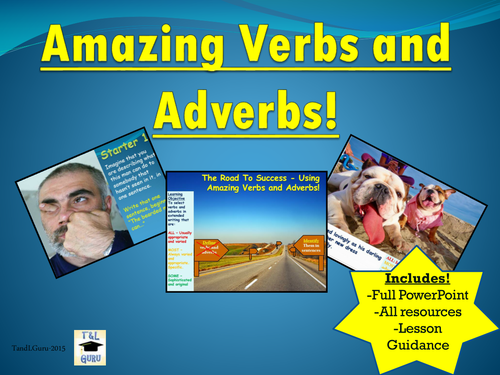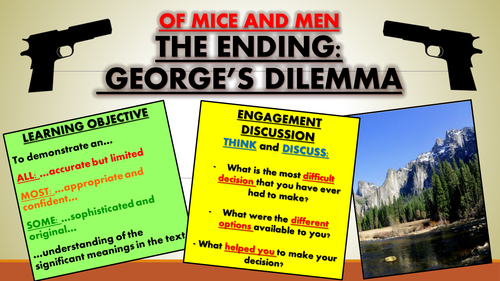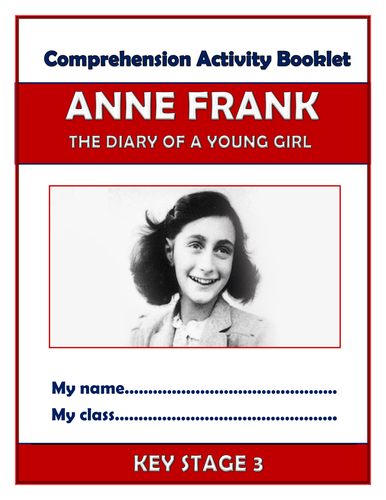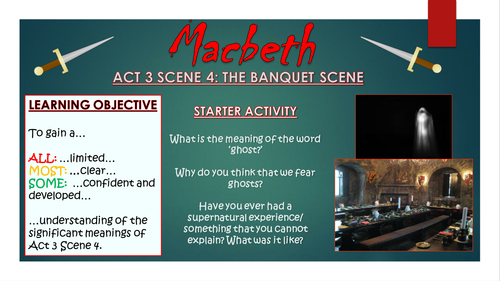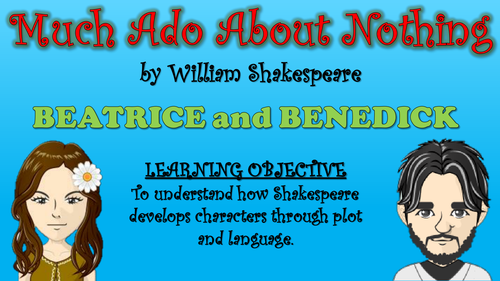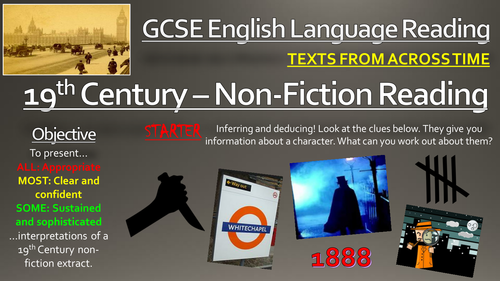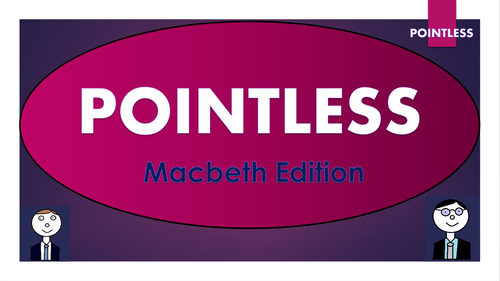
3k+Uploads
1967k+Views
2278k+Downloads
Pedagogy and professional development

Of Mice and Men - The Themes of Dreams and Loneliness
This engaging and interesting lesson aims to improve students' knowledge of the main themes (Dreams and Loneliness) in John Steinbeck's Of Mice and Men. It also aims to build their skills in retrieving information from texts, understanding the writer's ideas and opinions, and making precise and confident interpretations about texts.
The lesson uses a range of tasks, that require students to use their visual and interactive skills. It follows this learning journey:
- Understanding what dreams and loneliness are, and how we each experience them;
- Defining themes and understanding how writers use them;
- Understanding how and why themes are used in other famous texts;
- Retrieving evidence from the text to demonstrate where the characters experience dreams and loneliness;
- Analysing how the themes are used to help get across John Steinbeck's ideas about 1930s America;
- Evaluating each others' analytical attempts.
The resource includes a comprehensive and visually engaging PowerPoint presentation, a worksheet for recording the retrieved quotations, a helpful template for the main task, and a lesson plan/ teacher guidance sheet.
All images in this resource are licensed for commercial use, and are cited on the final slide of the lesson presentation.
You can choose to buy this resource alone, or as part of the 'Of Mice and Men - All Lessons and Scheme' bundle, which contains seven full lessons, resources, teachers notes, and PowerPoint presentations, plus a Pointless Of Mice and Men game, for just £5!
Bundle

A View from the Bridge Huge Bundle!
THIS BUNDLE CONTAINS ALL OF THE 'A VIEW FROM THE BRIDGE LESSONS, IN ADDITION TO THE COMPREHENSION BOOKLET, THE KNOWLEDGE ORGANISER AND THE POINTLESS GAME!
This engaging, varied, and informative scheme of learning is designed to help students gain understanding, assessment skills, and key interpretations of Arthur Miller’s play ‘A View from the Bridge.’ Made up of a wide-range of interesting and exciting lessons, students should complete this scheme having gathered vital skills in: interpreting the significant meanings of the text, understanding the writer’s ideas within the text, identifying the traits of key characters, settings, and themes, understanding dramatic and language devices, and relating the text to its social and historical context.
Stimulating, visual, and easily adaptable, these lessons provide suggested learning objectives and outcomes for students of a wide-range of abilities - The vast majority of tasks are differentiated to allow for different abilities and needs in your classroom. Each lesson loosely follows this logical learning journey to ensure that students learn in bite-size steps:
- Engaging
- Defining/ Understanding
- Identifying/Remembering
- Analysing/ Creating
- Peer or self evaluating.
All of the lessons are interactive, employ a variety of different teaching and learning methods and styles, and are visually-engaging. Resources, worksheets, and lesson plans are all provided.
Bundle

Frankenstein Lesson Bundle! (All Lessons, Resources, Plans, Everything!)
This engaging, varied, and informative scheme of learning is designed to help students gain a valuable understanding of Mary Shelley's horror classic 'Frankenstein.' The lessons enable students to gain a comprehensive understanding of the key features of plot, character, context, and language, in addition to considering the key themes and ideas running throughout the text.
All of the resources that you need are included in the bundle: informative and engaging whole lesson PowerPoints, worksheets, activities, and lesson plans.
The bundle is made up of a wide-range of interesting and exciting lessons, including:
- The Context of Frankenstein;
- Victor Frankenstein - The Tragic Hero;
- Shifting Narrative Viewpoints:
- Shelley's Description of the Monster;
- The Monster's Murders - Justified?
Stimulating, visual, and easily adaptable, these lessons provide suggested learning objectives and outcomes for students of a wide-range of abilities - The vast majority of tasks are differentiated to allow for different abilities and needs in your classroom. Each lesson loosely follows this logical learning journey to ensure that students learn in bite-size steps:
- Engaging
- Defining/ Understanding
- Identifying/Remembering
- Analysing/ Creating
- Peer or self evaluating.
All of the lessons are interactive, employ a variety of different teaching and learning methods and styles, and are visually-engaging.
Bundle

Teaching and Learning CPD Bundle!
These teaching and learning CPD sessions offer engaging and original approaches to introducing or revisiting a range of effective pedagogical strategies. Grounded in educational research, these sessions are interactive, well-structured, and have been successfully tried and tested.
The aim of each teaching and learning CPD session is to develop the knowledge, skills, and strategies needed in order to utilise in practice in each key area, and as an aid in achieving these aims, the trainer is supported with:
-Colourful, engaging, and comprehensive PowerPoint presentations;
-Videos for analysis of key techniques;
-A wide range of interactive resources for CPD activities;
-Instructions and plans to assist delivery.
All images and videos are licensed for commercial use, and are cited on the final slide of each PowerPoint.

Amazing Verbs and Adverbs!
This is an exciting and engaging lesson/set of tasks aiming to build students' skills at using varied verbs and adverbs in their writing . It was taught during an observation lesson where the teacher received an Outstanding judgement.
Students learn to:
- Define and give examples of what verbs and adverbs are;
- Identify verbs and adverbs on funny posters and captions;
- Analyse what makes verbs and adverbs effective;
- Create their own verb and adverb filled writing piece;
It comes complete with:
- Engaging and visual PowerPoint to guide students (and teacher!) through the lesson;
- Colourful and thought-provoking worksheet for the main analysis task;
- Lesson plan/ teacher guidance sheet, which goes through the lesson step-by-step;
- Resources to enable the teacher to make 'flags' for the development task.
All pictures are licensed for commercial use, and image authors cited on the final slide.
This lesson can also be bought as part of the Descriptive Devices bundle for just £5. The bundle leads students through each language device needed in order to write to describe confidently.
Alternatively, you can buy the Descriptive Writing Big Bundle (All descriptive devices lessons, structuring and organising writing lesson, capturing the readers attention lesson, and the literacy writing mat) for £6.

Ozymandias - Percy Bysshe Shelley
This engaging, comprehensive lesson provides an interesting and highly-informative study of Percy Bysshe Shelley's power and conflict poem: 'Ozymandias.' Throughout the lesson, students gain a detailed understanding of the poem, with a particular focus upon the content, language, and structural features employed by Shelley. By the end of the lesson, students demonstrate their knowledge of the text analytically, through assured, appropriate, and sustained interpretations.
The lesson follows a step-by-step learning journey, in which children learn through:
- Defining the key concept of power, and considering its role and implications in man's actions;
- Securing contextual understanding of both Ozymandias the ruler, and Percy Bysshe Shelley the poet;
- Reading and interpreting the poem, using a provided line-by-line analysis, and interactive group activities;
- Developing their understanding through inferring and analysing key language and structural choices;
- Analysing how the theme of power is explored through Shelley's content, language, and structure;
- Peer assessing each other's learning attempts.
Included is:
- Whole lesson PowerPoint - colourful and substantial; (including hyperlinks to informative and engaging videos)
- Copy of poem;
- Content, language and structure mind map;
- Deeper thinking worksheet;
- Analysis template with success criteria for creating well-structured responses;
- Comprehensive lesson plan.
There are also opportunities for group learning, peer assessment, and whole class discussion. This was originally taught to middle-ability year 9/10 groups, but can easily be differentiated for groups of different ages and abilities.
All images are licensed for commercial use, and image rights are listed on the last page of the presentation.

Of Mice and Men: The Ending - George's Dilemma
This engaging and interesting lesson aims to improve students' knowledge of the final events of the novel (the killing of Lennie by his best friend, George) in John Steinbeck's Of Mice and Men. It also aims to build their skills in retrieving information from texts, understanding the writer's ideas and opinions, and making precise and confident interpretations about texts.
The lesson uses a range of tasks, that require students to use their visual and interpersonal skills. It follows this learning journey:
- Reading, and interpreting the ending of the text;
- Inferring the hidden meanings in the final section of the text;
- Identifying the options available to George, and evaluating the pros and cons for each of them;
- Arguing a viewpoint either justifying or condemning George's actions;
- Evaluating each others' argumentative attempts.
The resource includes a comprehensive and visually engaging PowerPoint presentation, a worksheet to evaluate George's reasoning, an abstract from the text, a help-sheet for writing to analyse, and a lesson plan/ teacher guidance sheet.
All images in this resource are licensed for commercial use, and are cited on the final slide of the lesson presentation.
You can choose to buy this resource alone, or as part of the 'Of Mice and Men - All Lessons and Scheme' bundle, which contains seven full lessons, resources, teachers notes, and PowerPoint presentations, plus a Pointless Of Mice and Men game, for just £5!
Bundle

Year 5-6 SPAG Bundle!
These engaging and detailed resources have been designed to make the learning of SPAG concepts in the upper Key Stage 2 curriculum easily accessible, engaging and interesting for all children. Throughout each lesson, students learn to improve their skill at using appropriate, concise, and precise spelling, punctuation, and grammar, and practice employing them within their own writing compositions. Each lesson contains a comprehensive whole lesson PowerPoint, all of the worksheets/ resources that you will need, and a lesson plan.
The pack also includes a literacy writing mat to help students build their extended writing skills.
All images are licensed for commercial use, and are cited on the final slide of the PowerPoint/ the bottom of worksheets.

Anne Frank - Diary of a Young Girl - KS3 Comprehension Activities Booklet!
This resource booklet contains a wide range of age-appropriate, engaging, and meaningful comprehension activities for use throughout the reading of Anne Frank's 'Diary of a Young Girl.' Teachers have found them particularly useful in comprehension or guided reading sessions. They are perfect for aiding the progress of children towards meeting the KS3 expectations within the new National Curriculum framework. Children have found these resources extremely engaging, and for teachers there is explicit information within each task regarding which comprehension strands the task is designed to demonstrate. They also relate to key extracts, characters, and themes from the story, ensuring that children gain a deep understanding of the text.
Activities within the booklet include:
- 'Context: The Holocaust' - to enable students to demonstrate that they can: 'Know the purpose, audience and context of the writing and drawing on this knowledge to support comprehension.'
- 'Anne's Description - The Annex' - to enable students to demonstrate that they can: 'Know how language, including figurative language, vocabulary choice, grammar, text structure and organisational features, present meaning.'
- 'Otto Frank and 'Peter van Daan' - to enable students to demonstrate that they can: 'Study setting, plot, and characterisation, and the effects of these.'
- 'Vocabulary Inspector' - to enable students to demonstrate that they can: 'Learn new vocabulary, relating it explicitly to known vocabulary and understanding it with the help of context and dictionaries.'
Plus many, many more activities (the booklet is 21 pages in length!) I've also added it as a PDF in case the formatting differs on your computer.
All images are licensed for commercial use, and are cited on a separate document (included).

Macbeth: Act 3 Scene 4 - The Ghost (Banquet) Scene!
This lesson aims to improve students’ understanding of one of the key scenes in William Shakespeare’s Macbeth – Act III Scene IV. In particular, they learn to make insightful interpretations about the changing nature of Macbeth’s tone throughout the scene, and are enabled to understand how this would have affected Shakespearean audiences.
The lesson utilises a range of tasks, that require students to be visual and interactive learners. It follows this learning journey:
- Defining the key term 'tone' and establishing its importance as a literary technique;
- Understanding how tone is used to depict mood and attitude across a range of fiction;
- Reading and interpreting Act 3 Scene 4, and establishing how Macbeth's tone alters throughout;
- Reflecting upon why this may/ what effect this may have had on audiences at the time;
- Summarising the events of the scene;
- Analysing Shakespeare's intentions in sharply altering Macbeth's tone throughout;
- Peer/self evaluating the learning in the lesson.
Included in this resource pack are:
- A well-presented, thorough, and informative, whole-lesson PowerPoint presentation;
- Resources for the reading and interpreting activity - full scene transcript with space for notes;
- A template to help scaffold the main task, complete with P.E.E instructions;
- Cards for the card sorting group activity
- A comprehensive teacher guidance form/lesson plan to assist delivery.
All images in this resource are licensed for commercial use, and are cited on the final slide of the lesson presentation.

Much Ado About Nothing - Beatrice and Benedick!
This engaging, in-depth lesson enables students to understand how plot and language are utilised to develop the characters of Beatrice and Benedick in William Shakespeare’s ‘Much Ado about Nothing.’
The lesson places a particular focus upon how language is used between the two characters to present the audience with ideas about their intelligence, attitudes, and emotions. Students also analyse how their behaviour develops over the course of the text.
The lesson follows a step-by-step learning journey, in which students learn through:
- Taking part in a fun team quiz to secure understanding of the two characters;
- Completing a 'love graph' (backed up with textual evidence) to show how the prevailing attitudes and emotions of the two characters develops through the text;
- Analysing quotations in which Shakespeare used advanced language techniques to portray both of the characters in a particular light;
- Completing an essay style response in which they consider how Shakespeare's use of language helps to develop the two characters;
- Peer assessing each other's learning attempts.
Included is:
- Whole lesson PowerPoint - colourful and detailed - just download and teach from it!
- Love Graph - to track the two characters' feelings towards one another;
- 'Beatrice and Benedick Quotations' worksheet;
- Analysis template with success criteria for creating well-structured responses;
- Comprehensive lesson plan.
There are also opportunities for group learning, peer assessment, and whole class discussion. This was originally taught to higher-ability year 9 and 10 groups, but can easily be differentiated for groups of different ages and abilities.

New GCSE English Language Reading: 19th Century Non-Fiction
These informative and engaging resources enable students to build the skills needed to interpret and analyse 19th Century non-fiction texts. This will aid students through the new Paper 2 Section A of GCSE English Language - for which they need to become confident readers of 19th, 20th, and 21st Century non-fiction texts. These resources give students a strong foundation of knowledge of features of non-fiction texts in the 19th Century, using newspaper stories from the time based on 'Jack the Ripper' as the predominant examples. There are easily enough resources for at least two lessons within this resource pack.
Students learn through the following tasks:
- Inferring and deducing contextual knowledge through an interactive starter task;
- Understanding the features of London in 1888 through a video introduction;
- Building close reading skills through a study of a non-fiction extract about Jack the Ripper;
- Answering exam-style questions interpreting and inferring the key meanings in the text;
- Using models and templates to write extended analysis responses about the language used in the non-fiction extract;
- Peer assessing their partners' learning attempts.
The following resources are provided:
- Engaging and colourful step-by-step PowerPoint;
- Jack the Ripper newspaper extract;
- Teacher lesson guidance;
- Interpretation worksheet;
- Analysis worksheet;
- Writing to analyse.
All images are licensed for commercial use, and are cited on the final slide of the PowerPoint.
Bundle

Recount, Diary, and Autobiographical Writing!
These engaging and detailed resources have been designed to make the learning of Recount, Diary, and Autobiography writing forms easily accessible, engaging and interesting for all children. Throughout each lesson, students learn to improve their skill at using appropriate, concise, and precise spelling, punctuation, and grammar, and practice employing them within their own writing compositions. Each lesson contains a comprehensive whole lesson PowerPoint, all the resources that you will need, and a lesson plan.
The pack also includes a literacy writing mat to help students build their extended writing skills.
All images are licensed for commercial use, and are cited on the final slide of the PowerPoint/ the bottom of worksheets.
Bundle

An Inspector Calls Huge Bundle!
THIS HUGE BUNDLE PACK CONTAINS ALL OF THE 'AN INSPECTOR CALLS LESSONS, IN ADDITION TO THE COMPREHENSION BOOKLET, THE KNOWLEDGE ORGANISER, AND THE POINTLESS GAME!
This engaging, varied, and informative scheme of learning is designed to help students gain a valuable understanding of J.B Priestley’s classic play ‘An Inspector Calls.’ The lessons enable students to gain a comprehensive understanding of the key features of plot, character, context, and language, in addition to considering the key messages being offered by Priestley.
All of the resources that you need are included in the bundle: informative and engaging whole lesson PowerPoints, worksheets, activities, and lesson plans.
The bundle is made up of a wide-range of interesting and exciting lessons, including:
- The Context of the Play;
- Arthur Birling;
- Priestley’s Dramatic Devices;
- Sheila and Gerald;
- Sybil and Eric Birling Double Lesson;
- Inspector Goole (Priestley’s message)
- The An Inspector Calls Pointless Game.
- The An Inspector Calls Comprehension Activity Booklet.
Stimulating, visual, and easily adaptable, these lessons provide suggested learning objectives and outcomes for students of a wide-range of abilities - The vast majority of tasks are differentiated to allow for different abilities and needs in your classroom. Each lesson loosely follows this logical learning journey to ensure that students learn in bite-size steps:
- Engaging
- Defining/ Understanding
- Identifying/Remembering
- Analysing/ Creating
- Peer or self evaluating.
All of the lessons are interactive, employ a variety of different teaching and learning methods and styles, and are visually-engaging.
Bundle

Travel Writing Big Bundle!
Contains all of the Travel Writing Lessons Travel Brochure Writing!
These engaging and detailed resources have been designed to make the teaching and learning of Travel Writing exciting, interesting, and easily accessible for all children. Throughout each lesson, students consider a different element of their writing (content, language, and structure) in order to produce imaginative and appropriate travel writing texts. Each lesson contains a comprehensive whole lesson PowerPoint, all the resources that you will need, and a lesson plan.
Included are the following lessons:
1. Travel Writing: Crafting Imaginative Content
2. Travel Writing: Constructing Imaginative Language;
3. Travel Writing: Creating Imaginative Structures
4. Travel Brochure Writing
All images are licensed for commercial use, and are cited on the final slide of the PowerPoint/ the bottom of worksheets.
Bundle

Much Ado About Nothing Big Bundle! (All Lessons, Resources, Plans, Everything!)
THIS BUNDLE CONTAINS ALL OF THE ‘MUCH ADO ABOUT NOTHING’ LESSONS, PLUS THE COMPREHENSION BOOKLETS (for both KS3 and KS4) AND THE POINTLESS GAME!
This engaging, varied, and informative scheme of learning is designed to help students gain understanding, assessment skills, and key interpretations of William Shakespeare’s tragedy ‘Much Ado About Nothing.’ Made up of a wide-range of interesting and exciting lessons, students should complete this scheme having gathered vital skills in: interpreting the significant meanings of the text, understanding the writer’s ideas within the text, identifying the traits of key characters, settings, and themes, understanding dramatic and language devices, and relating the text to its social and historical context.
Stimulating, visual, and easily adaptable, these lessons provide suggested learning objectives and outcomes for students of a wide-range of abilities - The vast majority of tasks are differentiated to allow for different abilities and needs in your classroom. Each lesson loosely follows this logical learning journey to ensure that students learn in bite-size steps:
- Engaging
- Defining/ Understanding
- Identifying/Remembering
- Analysing/ Creating
- Peer or self evaluating.
All of the lessons are interactive, employ a variety of different teaching and learning methods and styles, and are visually-engaging. Resources, worksheets, and lesson plans are all provided. There is a 20 page comprehension booklet, and also a fun ‘Pointless’ Game included, to enhance your students’ knowledge of the text!
Bundle

Personal Development Assemblies Huge Bundle!
These fun and original assemblies have been designed aid children in developing their skills of:
Compassion
Honesty
Resilience
Humility
Celebrating differences
Thankfulness
Patience
Peace
Creativity
All of the assemblies are tried and tested, and each has been really well received in the past.
The slides are visually engaging and well-presented, and the subject matter is tailored to the interests and needs of young people. For example, there are references to scenarios and dilemmas that they themselves might find themselves in, in order to help them to make the right choices in their own lives.
There are also fun role-play activities, beautiful, thought-provoking videos exemplifying each theme, and various discussion activities regarding how to show the skills in different areas of their own lives. No further resources are required, everything that you need to present the assemblies is included.
Each set of slides are fairly self-explanatory, but I’ve included guidance notes for each assembly to assist the speaker. Hope that you find this useful!

Frankenstein: The Context of Frankenstein
This engaging and detailed lesson aims to improve students’ understanding of the social and historical context of Mary Shelley’s gothic horror novel: Frankenstein. The lesson places a particular focus upon the developments in health, science, and technology at the time the text was written and set, the locations visited by the author, and the life of Mary Shelley. By the end of the lesson, students demonstrate their ability to link their understanding of context to specific sections of the text.
The lesson follows a step-by-step learning journey, in which children learn through:
- Considering how life has changed between the end of the 18th Century and the present day;
- Researching key information about health, scientific understanding, and major events in the late 1700s;
- Understanding the features of locations in the novel, and interpreting what they may symbolise;
- Developing their understanding of the author: Mary Shelley, and considering the key events in her life that influenced her writing of Frankenstein;
- Linking knowledge of time, place, and author, and relating these to specific areas of the text;
- Peer assessing each other's learning attempts.
Included is:
- Whole lesson PowerPoint - colourful and substantial; (including an animated Frankenstein's monster to guide them through the lesson, and links to helpful websites);
- Comparison between 1700s and the present day worksheet (and a teacher answer sheet);
- Card sorting activity based on locations in the novel;
- Mary Shelley worksheet (and a teacher answer sheet);
- Analysis template with success criteria for creating well-structured responses;
- Comprehensive lesson plan.
There are also opportunities for group learning, peer assessment, and whole class discussion. This was originally taught to middle-ability year 9/10 groups, but can easily be differentiated for groups of different ages and abilities.
All images are licensed for commercial use, and image rights are listed on the last page of the presentation. NOTE: One of the tasks requires access to researching materials, e.g. internet or library access.

Dr Jekyll and Mr Hyde: Description of Mr Hyde!
This engaging and informative lesson enables students to make sustained and insightful interpretations of Stevenson’s language when describing Mr Hyde throughout the novella ‘Strange Case of Dr Jekyll and Mr Hyde.’ In particular, students analyse how the use of similes, varied verbs, and repetition, contribute to the portrayal of devilish man deprived of a social or moral conscience.
The lesson follows a step-by-step learning journey, in which children learn through:
- Understanding key information about 19th Century morality, and learning how the character of Hyde becomes separated from these ideals;
- Reading and comprehending key extracts describing Hyde in the text;
- Exemplifying and analysing Stevenson's use of language devices across his description;
- Describing their own immoral/hideous character utilising the same descriptive techniques;
- Peer assessing each other's learning attempts.
Included is:
- Whole lesson PowerPoint - colourful and comprehensive;
- Selected extracts from the text describing Hyde;
- Stevenson's Language worksheet (and completed answer sheet for teachers);
- Analysis template with success criteria for creating well-structured responses;
- Links to further reading for advanced students (internet access needed for these);
- Comprehensive lesson plan.
There are also opportunities for group learning, peer assessment, and whole class discussion. These resources were originally taught to GCSE students, but with subtle adaptations they have also been used with KS3 and A Level Students.
All images are licensed for commercial use, and image rights are listed on the last page of the presentation.

Pointless Game - Macbeth Edition
Based on the popular game show 'Pointless', this resource is perfect for use as a starter activity, plenary, or revision tool. Editable, so that you can change to any other topic or change questions. Containing almost 30 slides of sound clips, engaging visuals, and suitably challenging questions, this resource is effective at both promoting engagement and enhancing learning. There are several full rounds of questions to build learning of Macbeth:
1. The characters in Macbeth
2. Quotations from the text
3. Settings, themes, and character titles
4. Murders in Macbeth
The nature of the game ensures that this resource can challenge students of all levels.
NOTE: You can buy this resource alone, or in a bundle of 8 Pointless games, for only £1 more!





